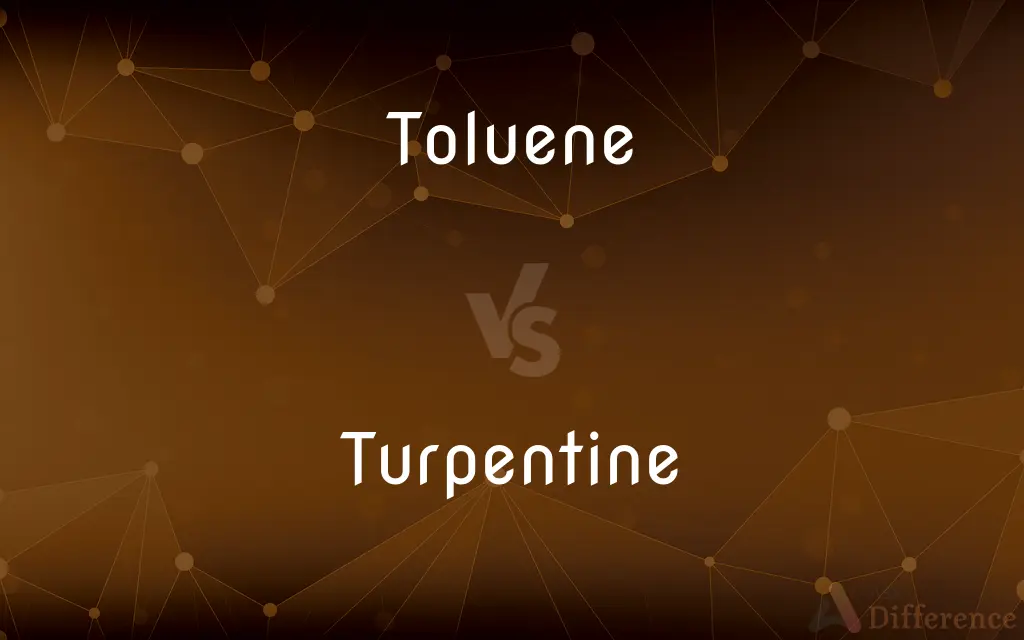Toluene vs. Turpentine — What's the Difference?
By Urooj Arif & Maham Liaqat — Updated on March 29, 2024
Toluene is a chemical solvent derived from petroleum, known for its use in industrial and lab settings, while turpentine is a natural solvent obtained from pine tree resin, used mainly in art and cleaning.

Difference Between Toluene and Turpentine
Table of Contents
ADVERTISEMENT
Key Differences
Toluene, a hydrocarbon, is primarily used in industrial applications for its solvent properties, capable of dissolving paints, silicones, and rubber, offering a clear, colorless liquid with a distinctive smell. Whereas turpentine, derived from the distillation of pine resin, serves a dual role in both the art world as a paint thinner and in traditional cleaning practices, characterized by its strong piney odor.
In the realm of safety and health, toluene poses significant risks with prolonged exposure, potentially affecting the central nervous system and causing serious health issues, while turpentine, though natural, can still be toxic if inhaled or ingested, demanding caution in its use.
Environmentally, toluene's production and use are subject to stringent regulations due to its volatile organic compound (VOC) status, contributing to air pollution and necessitating careful handling. On the other hand, turpentine, being a natural product, is considered more environmentally friendly, yet its extraction and distillation process can impact forest ecosystems.
Toluene's versatility extends beyond solvent applications into the production of chemicals like benzene and xylene, showcasing its importance in chemical synthesis. Turpentine, however, finds its niche in the production of varnishes, resins, and camphor, highlighting its value in specific industrial and commercial sectors.
Comparison Chart
Origin
Derived from petroleum
Distilled from pine tree resin
ADVERTISEMENT
Primary Use
Industrial solvent
Solvent in art and cleaner
Health Risks
Affects central nervous system, potential toxicity
Toxic if inhaled/ingested, less toxic than toluene
Environmental Impact
High, due to VOC status
Lower, natural product but can impact forests
Additional Applications
Chemical synthesis (benzene, xylene production)
Production of varnishes, resins, camphor
Compare with Definitions
Toluene
Industrial Applications.
Toluene is essential in the manufacture of paints and glues.
Turpentine
Derived from Pine Resin.
Turpentine is produced by distilling the resin from pine trees.
Toluene
Derived from Petroleum.
Toluene is obtained through the refining process of crude oil.
Turpentine
Natural Solvent.
Artists use turpentine to thin oil paints and clean brushes.
Toluene
Chemical Solvent.
Toluene is widely used in laboratories to dissolve other substances.
Turpentine
Used in Varnish Production.
Turpentine is a key ingredient in the production of varnishes.
Toluene
Central Nervous System Risk.
Exposure to toluene can lead to significant health issues.
Turpentine
Cleaning Agent.
Turpentine has been traditionally used as a powerful cleaner.
Toluene
Used in Chemical Synthesis.
Toluene is a precursor in the synthesis of benzene and xylene.
Turpentine
Environmental Considerations.
While turpentine is natural, its production affects forest areas.
Toluene
Toluene (), also known as toluol (), is an aromatic hydrocarbon. It is a colorless, water-insoluble liquid with the smell associated with paint thinners.
Turpentine
Turpentine (which is also called gum turpentine, spirit of turpentine, oil of turpentine, wood turpentine, terebenthene, terebinthine and (colloquially), turps) is a fluid obtained by the distillation of resin harvested from living trees, mainly pines. Mainly used as a specialized solvent, it is also a source of material for organic syntheses.
Toluene
A colorless flammable aromatic liquid, C7H8, obtained from coal tar or petroleum and used in aviation fuel and other high-octane fuels, in dyestuffs, explosives, and as a solvent for gums and lacquers. Also called methylbenzene.
Turpentine
A volatile pungent oil distilled from gum turpentine or pine wood, used in mixing paints and varnishes and in liniment.
Toluene
(organic compound) A colourless, inflammable liquid hydrocarbon, methylbenzene, CH3.C6H5, used as a solvent, in high-octane fuels and in the production of many chemical compounds.
Turpentine
Any of a number of trees which yield turpentine or a similar resin.
Toluene
A hydrocarbon, C6H5.CH3, of the aromatic series, homologous with benzene, and obtained as a light mobile colorless liquid, by distilling tolu balsam, coal tar, etc.; - called also methyl benzene, phenyl methane, etc.
Turpentine
Apply turpentine to
Antique turpentining equipment
Toluene
A colorless flammable liquid obtained from petroleum or coal tar; used as a solvent for gums and lacquers and in high-octane fuels
Turpentine
A thin volatile terpenoid essential oil, C10H16, obtained by steam distillation or other means from the wood or exudate of certain pine trees and used as a paint thinner, solvent, and medicinally as a liniment. Also called oil of turpentine, spirit of turpentine.
Turpentine
The sticky mixture of resin and volatile oil from which turpentine is distilled.
Turpentine
A brownish-yellow resinous liquid obtained from the terebinth.
Turpentine
To apply turpentine to or mix turpentine with.
Turpentine
To extract turpentine from (a tree).
Turpentine
Any oleoresin secreted by the wood or bark of certain trees.
Turpentine
A volatile essential oil now obtained from such oleoresin of from the wood of pine trees by steam distillation; a complex mixture of monoterpenes; now used as a solvent and paint thinner.
Turpentine
(transitive) To drain resin from (a tree) for use in making turpentine.
Turpentine
A semifluid or fluid oleoresin, primarily the exudation of the terebinth, or turpentine, tree (Pistacia Terebinthus), a native of the Mediterranean region. It is also obtained from many coniferous trees, especially species of pine, larch, and fir.
Turpentine
Obtained from conifers (especially pines)
Turpentine
Volatile liquid distilled from turpentine oleoresin; used as paint thinner and solvent and medicinally
Common Curiosities
Are toluene and turpentine interchangeable?
No, they serve different purposes and have distinct properties.
Can both toluene and turpentine be used as paint thinners?
Yes, but they are used in different contexts and materials.
What are the health risks of turpentine?
Inhalation or ingestion can be toxic, but it's generally less toxic than toluene.
Can toluene affect the nervous system?
Yes, prolonged exposure can have adverse effects on the central nervous system.
Is toluene more toxic than turpentine?
Yes, toluene is generally considered more toxic.
What is toluene used for?
Toluene is mainly used as a solvent in industrial applications.
Is turpentine environmentally friendly?
While natural, its production and use can have environmental impacts.
Does toluene have uses beyond being a solvent?
Yes, it's used in chemical synthesis and as a fuel additive.
How is turpentine obtained?
Turpentine is obtained by distilling resin from pine trees.
What precautions should be taken when using toluene?
Use in a well-ventilated area and avoid prolonged exposure.
How does the environmental impact of turpentine compare to toluene?
Turpentine is considered less harmful but still poses risks.
Is turpentine derived from all types of pine trees?
Mostly, but some types of pine trees are preferred for their resin quality.
How are toluene and turpentine regulated?
Both are subject to regulation due to their potential health and environmental impacts.
Can toluene be found in everyday products?
Yes, in items like nail polish removers and paint thinners.
What is a common use of turpentine in art?
As a thinner for oil-based paints and for cleaning brushes.
Share Your Discovery

Previous Comparison
Bunker vs. Fort
Next Comparison
Cubic vs. CubicalAuthor Spotlight
Written by
Urooj ArifUrooj is a skilled content writer at Ask Difference, known for her exceptional ability to simplify complex topics into engaging and informative content. With a passion for research and a flair for clear, concise writing, she consistently delivers articles that resonate with our diverse audience.
Co-written by
Maham Liaqat












































